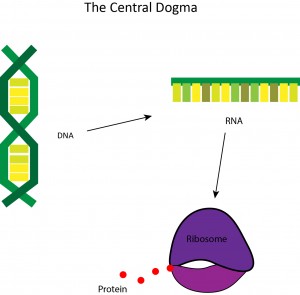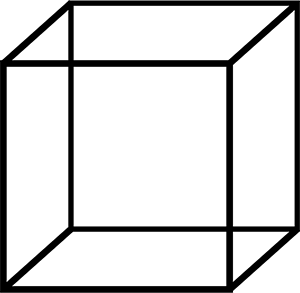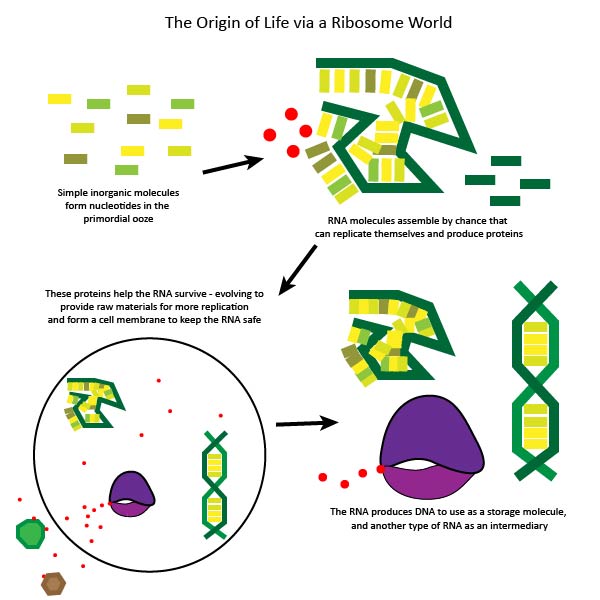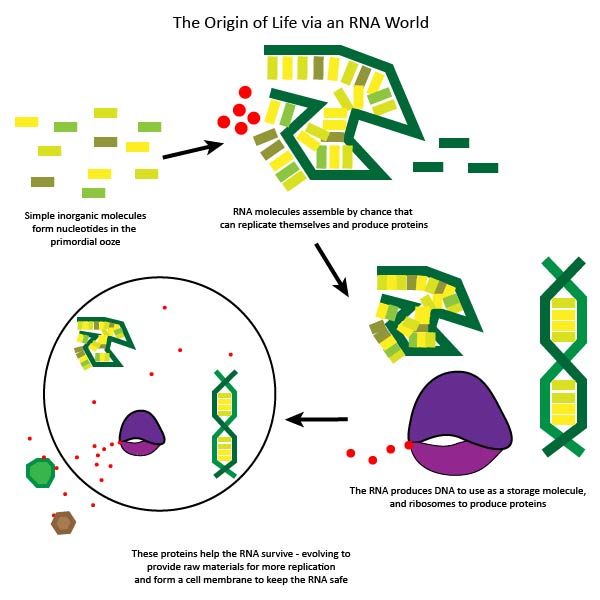“What Does DNA Want?”
The innocent question from a small child that caused the biological necker cube to flip for Meredith and Robert Root-Bernsteina, researchers at Oxford University and Michigan State University, whose ground-breaking paper appears in the Journal of Theoretical Biology today.
The Central Dogma
 At school we are taught the central dogma of biology – DNA is the storage molecule, the hard drive of our cells; RNA (a single-stranded variant of DNA) is used to copy and transport the code of specific regions (genes) so that they can be translated into proteins by Ribosomes (three-dimensional structures of protein and RNA). This is not a lie told to simplify the truth during early school – the central dogma persists right through to University level. It’s called the central dogma for a reason.
At school we are taught the central dogma of biology – DNA is the storage molecule, the hard drive of our cells; RNA (a single-stranded variant of DNA) is used to copy and transport the code of specific regions (genes) so that they can be translated into proteins by Ribosomes (three-dimensional structures of protein and RNA). This is not a lie told to simplify the truth during early school – the central dogma persists right through to University level. It’s called the central dogma for a reason.
As Darwin’s theory became widely accepted, it was initially assumed that the fundamental unit of life was the organism, the individual. DNA acted as a recipe book, a stored blueprint for building that individual, and the individual could replicate itself by producing offspring who carried the same (or partly the same) recipe book. In 1976 however, Richard Dawkins flipped the necker cube for the first time, revealing the importance of the gene. In his exemplary book, The Selfish Gene, Dawkins explained in beautiful simplicity why it was that our attempts to understand the behaviour of whole organisms was falling short – we needed to think in terms of selfish genes not individuals. In this view of life, the gene is the fundamental unit. Genes have one goal and one goal only – to keep existing. To achieve this goal they direct a mind-boggling array of carefully controlled chemical reactions that together produce a cell, replicate the cell until there are trillions of copies and organise those cells into an organism, whose form and behaviour will hopefully enable it to reproduce and pass those genes on to the next generation. Through this angle of the necker cube, biology – reproduction, conflict, cooperation, society – all came into focus. The selfish gene concept revolutionised how we think about life and evolution, and it has served us well over the past 40 years.
But following a new paper released today in the Journal of Theoretical Biology, the necker cube may be about to flip again.
A Little Background
If you need a little refresher on biology, read on. Otherwise, if you understand the terms nucleotide, amino acid, organelle and LUCA you can skip ahead to the next section.
Nucleotides are the building blocks of RNA and DNA, and they come in four flavours (actually five, but we’ll see why the other one is a bit different in a moment) – Adenosine (A), Guanine (G), Cytosine (C) and Thymine (T). Nucleotides can form single strands, complex shapes or the famous double helix, but the have very specific pairing rules – A with G and C with T. These nucleotides, in their four flavours or letters, spell out the genetic code. They carry the recipe for the organism.
DNA is double-stranded, and is formed from the four nucleotides (also known as bases) I listed above. RNA, in contrast, is single-stranded and includes the fifth nucleotide, Uracil (U). Uracil replaces Thymine in RNA. The bases encode genetic information, but they can also create structural ‘docking’ sites which interact with other molecules, and in RNA, the bases can determine a three-dimensional structure for the molecule. This may endow the RNA molecule with the ability to catalyse reactions (an RNA enzyme), to match receptors and trigger hormonal changes or stimulate nerves. It might even, very rarely, allow the RNA molecule to replicate itself.
Proteins are, well, everything. Proteins form your cells and make up hair and nails, they form hormones and signalling molecules that allow you to interact with your surroundings. And they are the enzymes that conduct all the many chemical reactions necessary to keep you alive and being you. They are formed from amino acids, small molecules that exist in 21 different types (actually there’s a few more, but all living things only use these 21). Each amino acid is linked to at least one codon (a three-nucleotide string of DNA or RNA, essentially one ‘letter’ in the DNA code). In this way, DNA translates directly into protein – a 12 nucleotide base pair (bp) string of DNA encodes 4 amino acids – a very simple protein. Strung together in order by Ribosomes, the final 3D structure of the protein depends on the amino acid code and the properties of each amino acid. Ultimately, this 3D structure determines the function (or lack of) of the protein – as a structural protein, an enzyme, a hormone, a neurotransmitter.
Organelles are membrane-bound subunits within the cell that fulfil different tasks. For example, mitochondria are organelles that produce energy for the cell from glucose. In plants, chloroplasts are organelles that produce energy using sunlight. Ribosomes are organelles that translate RNA into protein. Many organelles contain their own DNA, and are thought to have originated through one living cell engulfing another and evolving to produce a symbiotic (mutually-beneficial) relationship. Chloroplasts are thought to have come endosymbiotic engulfment of cyanobacteria, and mitochondria from proteobacteria, millions of years ago.
LUCA is the Last Universal Common Ancestor of all life on Earth. It is the ancestor to every single living thing on Earth now, or that has ever existed. LUCA is thought to have been a single-celled organism that lived around 3.5 billion years ago. LUCA was not the first life, but the only life to reproduce and ultimately evolve to produce all life on Earth. Scientists can assume that any traits shared by all living organisms were probably present in LUCA, for example DNA, RNA, ribosomes, etc. Understanding what LUCA was like can help to illuminate the early origins and evolution of life.
An RNA World
One well accepted (although far from proven) hypothesis about the origin of life, goes something like this:
In the beginning, there were simple inorganic molecules such as hydrogen and ammonia. Somewhere on Earth, perhaps in the sea, perhaps in ice, perhaps in crystals or on rocks, these simple molecules came together and started to form organic monomers – nucleotides and amino acids. Over time the nucleotides bonded in specific ways to form RNA molecules. Many of these random molecules simply broke apart again, but some by chance had a 3D structure that allowed them to perform a particular task – to join more nucleotides together and replicate themselves.
In an instant, what we now call life, exploded into existence. These self replicating molecules kept producing more copies of themselves and with each replication, they introduced the opportunity for natural selection to generate gradual change and adaptation.
Over time, the self-replicating RNA molecules gathered many new functions – they started synthesising proteins that would help them to obtain more of the raw materials for replication. At some point, they started building membranes from fats and phosphate in order to keep their raw materials safe and keep out competing RNA molecules. The RNA molecules also started forming a storage molecule which was more stable – a place to store the blueprint for different proteins. In turn, the self-replicating RNA molecules created a new type of RNA molecule – the Ribosome. Ribosomes were formed from RNA (specifically ribosomal RNA or rRNA) and protein, and their role was to translate the blueprints stored in DNA into the correct proteins when needed. To do so they enlisted two new forms of RNA – transfer RNA (tRNA) and messenger RNA (mRNA).
Flipping the Necker Cube
So the story goes. Except Drs Root-Bernstein and Root-Bernstein think we might still be looking at this all from the wrong angle. They point out that along with DNA, all known living cells on Earth also share three things – ribosomes, cell membranes and acidocalicisomes (organelles responsible for storing and regulating ions). Further, they point out that the most stable, “default” structure of DNA is tightly coiled up so that it cannot be accessed or damaged. DNA is a storage molecule. For ribosomes, on the other hand, the default state, if you will, is to produce protein. The Root-Bernsteins argue that, of all the organelles that might be considered for the title of ‘functional unit of life’, ribosomes make the most sense.
 To whatever extent we can meaningfully say that any molecule or compound wants to do anything, Ribosomes want to create. They want to translate genes into proteins. A defining characteristic of the first life on Earth. Perhaps only one evolutionary step forward from the very bound of life itself.
To whatever extent we can meaningfully say that any molecule or compound wants to do anything, Ribosomes want to create. They want to translate genes into proteins. A defining characteristic of the first life on Earth. Perhaps only one evolutionary step forward from the very bound of life itself.
The boundary of life exists at the step from inorganic to self-replicating. The first inorganic molecule that, by chance, possessed the ability to replicate itself was, as soon as it existed, alive. The first life on Earth. So, ribosomes may want to use DNA as a blueprint to produce protein, but do ribosomes want to replicate themselves? A clear prerequiste for self replication would be genes encoded within rRNA to produce the proteins, rRNA, mRNA and tRNA necessary for protein translation. This would have once been used by the ribosome to produce more ribosomes – to self-replicate. So the authors looked to see if there was still any evidence of these ancient genes in the modern ribosomal genome.
By statistically comparing the E. coli genome with the sequences of tRNAs and ribosomal proteins, the authors were able to demonstrate vestiges of mRNAs, tRNAs and genes for ribosomal proteins and enzymes. Although no longer functional, they found evidence for all 20 tRNAs and every active site of the key ribosomal proteins. In fact, every single sequence of rRNA encoded functional information for manufacturing RNAs and proteins, whilst also playing a role in the three-dimensional structure of the ribosome (key to its function). This, they claim, suggests that ribosomes are the missing link between simple, pre-biotic molecules (nucleotides) and our oldest ancestor – the single celled organism known only as LUCA.
 Under this view, DNA evolved as a tool for ribosomes to conserve and protect the blueprints to their replication – the information encoded in rRNA. In turn, cells and organisms evolved just as we thought before, only instead of maximising the reproduction of selfish genes, they were maximising replication for selfish ribosomes. The ribosome we see today is a remnant of the primordial genome of a self-replicating, self-organising organism, and the transition from ‘living’ macromolecules to cellular life.
Under this view, DNA evolved as a tool for ribosomes to conserve and protect the blueprints to their replication – the information encoded in rRNA. In turn, cells and organisms evolved just as we thought before, only instead of maximising the reproduction of selfish genes, they were maximising replication for selfish ribosomes. The ribosome we see today is a remnant of the primordial genome of a self-replicating, self-organising organism, and the transition from ‘living’ macromolecules to cellular life.
This paper represents a strong challenge to the now well established selfish gene concept. If true, it fundamentally alters how we think about the earliest evolution of life itself.
Want to Know More?
- Root-Bernstein and Root-Bernstein (2014) The ribosome as a missing link in the evolution of life






